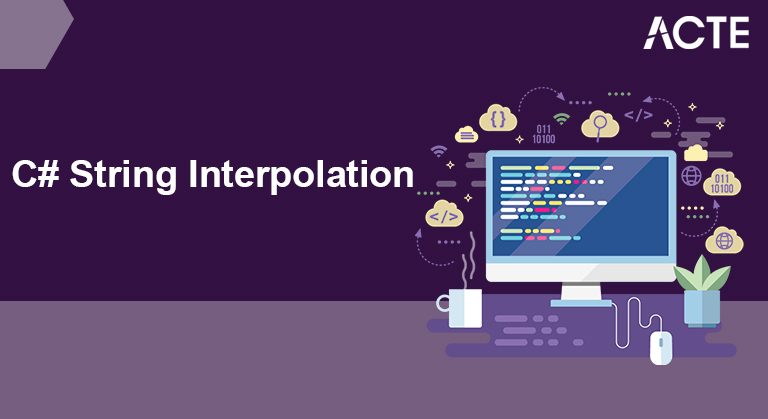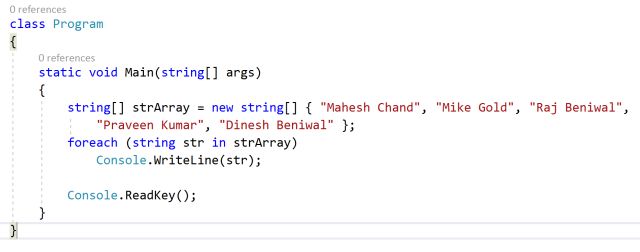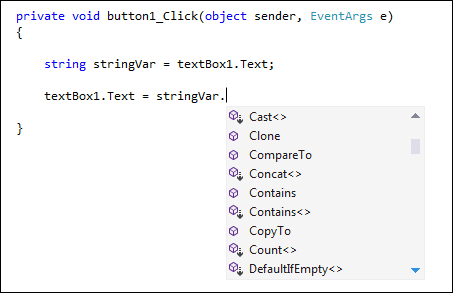
- Introduction to Strings in C#
- C# string definition
- What is a string in C# with the model?
- How would you involve strings in C#?
- What are C# strings?
- String Operationsin C#
- Properties for the String Class
- Some of the C# String methods are
- String Characteristics
- Contrasts among String and System.String
- Known contrasts among string and System.String in C#?
- Advantages of Strings in C#
- Conclusion
- System.String
- System.Text.StringBuilder
- By relegating a string exacting to a String variable
- By utilizing a String class constructor
- By utilizing the string connection administrator (+)
- By recovering property or calling a strategy that profits a string
- By calling an arranging strategy to change a worth or an article over to its string portrayal
- We can perform such activities utilizing the pre-characterized elements of the “string. h” header record. To utilize these string capacities, you should incorporate string. h record in your C program.
- The string insertion highlight is based on top of the composite organizing highlight and gives a more clear and advantageous language structure to incorporate designed articulation brings about an outcome string.
- To recognize a string exacting as an interjected string, prepend it with the $ image. You can implant any legitimate C# articulation that profits a worth in an interjected string. In the accompanying model, when articulation is assessed, its outcome is changed over into a string and remembered for an outcome string:
- string s1 = “A string is more “;
- string s2 = “than the number of its scorches.”;
- // Link s1 and s2. This really makes a new
- // string article and stores it in s1, delivering the
- // reference to the first item.
- s1 += s2;
- System.Console.WriteLine(s1);
- By appointing a string exacting to a String variable
- By utilizing a String class constructor
- By utilizing the string link administrator (+)
- By recovering property or calling a technique that profits a string
- By calling a designing strategy to change a worth or an item over to its string portrayal
- By appointing a string exacting to a String variable.
- By calling a String class constructor.
- By utilizing the string connection administrator (+ in C# and or + in Visual Basic) to make a solitary string from any blend of String occasions and string literals.
- string name = “John” + ” ” + “Doe”;
- Tracking down the length of a string
- Get the last 4 characters from string in C#
- Get the last 2 characters from the string involving Regex in C#
- The print first letter of each word in a string involving Regex in C#
- The print first letter of each word in a string in C#
- Track down the file of a word in a string in C#
- List all Substrings in a given String utilizing C#
- Split a string into spaces in C#
- Eliminate the end part of a string in C#
- Supplant portions of a string with Regex in C#
- Eliminate copy characters from String in C#
- Eliminating void areas involving String. Empty in C#
- Get initial three letters from each string in C#
- Split a string into components of a string exhibit in C#
- Split a string involving customary articulations in C#
- Check on the off chance that a Substring is available in a Given String in C#
- Meaning of multiline String Literal in C#
- Work out the length of the string utilizing C#
- Connection of two strings in C#
- Add string esteems to a C# list
- Include the vowels in a string in C#
- String design for Date Time in C#
- Count upper- and lower-case characters in a given string in C#
- Invert a String utilizing C#
- Arranging a String in C#
- Track down the initial 10 characters of a string in C#
- Track down the primary person of a string in C#
- Given beneath is the rundown of techniques for the String class.
- You can visit the MSDN library for the total rundown of strategies and String class constructors
- It is a reference type.
- It’s permanent (its state can’t be changed).
- It can contain nulls.
- Its over-burdens the operator (==).
- The String is utilized for the announcement yet System. The string is utilized for getting too static string techniques.
- The String is utilized to proclaim fields, properties, and so on that, it will utilize the predefined type System. String. It is a simple method for utilizing.
- The String needs to utilize the System. String class strategies, for example, String.SubString, String.IndexOf and so on The string is just a false name of System. String.
- String is a watchword and broadly utilized for announcing a variable. While System.The string is a class and utilized for getting to string static strategies like String.Format(), String.Compare() and so on
- You can utilize string straightforwardly in your program and you don’t have to add Using System namespace toward the start of your program through to utilizing System. The string you want to import Using System namespace.
- As a long guide to System.Int64, int guides to System.Int32 and a short guide to System.Int16; string guide to System.String.
- String objects the size of the stored string is variable and changeable.
- Boundary issues are handled inside the class library.
- More intuitive notations can be created.
- No Side Effects. Various pieces of the application can rely upon a solitary article.
- Moment Cloning.
- String Interning.
- String Safety.
- Code Readability.
Introduction to Strings in C#:
A string is an object of type String whose worth is text. Inside, the text is put away as a consecutive perused just assortment of Char objects. There is no invalid ending character toward the finish of a C# string; consequently, a C# string can contain quite a few inserted invalid characters (‘\0’). The Length property of a string addresses the quantity of Char objects it contains, not the quantity of Unicode characters. To get to the individual Unicode code focuses in a string, utilize the StringInfo object.
C# string definition:
A string is an arrangement of characters. In C#, a string is an arrangement of Unicode characters. It is an information type that stores an arrangement of information esteems, generally, bytes, in which components ordinarily represent characters as indicated by a person encoding. While a string shows up in a real sense in the source code, it is known as a string exacting.
Strings are objects. There are two fundamental classes for working with strings:
The String is a changeless succession of characters. The StringBuilder is an impermanent succession of characters. In C#, the string is a nom de plume for System. String. The string is a language watchword and the System. The string is a C# sort.
What is a string in C# with the model?
A string is an object of type String whose worth is text. Inside, the text is put away as a successive read-just assortment of Char objects. There is no invalid ending character toward the finish of a C# string; in this way, a C# string can contain quite a few inserted invalid characters (‘\0’).
Making a String Object
You can make a string object utilizing one of the accompanying strategies −
How would you involve strings in C#?
string text = “This is a “string” in C#. “; C# incorporates getting away from character \ (oblique punctuation line) before these exceptional characters to remember for a string. Use oblique punctuation line \ before twofold statements and a few unique characters, for example, \,\n,\r,\t, and so forth to remember it for a string.
Output:
A string is more than the amount of its singes.
What are C# strings?
In C#, the string is an arrangement of Unicode characters or exhibit of characters. The scope of Unicode characters will be U+0000 to U+FFFF. The variety of characters has likewise named the text. So the string is the portrayal of the text.
String versus System.String:
In C#, the string watchword is a nom de plume for String. Along these lines, String and string are the same, notwithstanding it is prescribed to utilize the gave nom de plume string as it works even without utilizing System. The String class gives numerous techniques to securely making, controlling, and looking at strings. Furthermore, the C# language over-burdens a few administrators to work on normal string activities. For more data about the watchword, see the string. For more data about the sort and its strategies, see String.
Creating a String Object:
You can make string objects utilizing one of the accompanying strategies −
The accompanying model shows this −
Unchanging nature of String Objects
String objects are unchanging: they can’t be changed after they have been made. All of the String techniques and C# administrators that seem to change a string return the outcomes in another string object. In the accompanying model, when the substance of s1 and s2 is connected to frame a solitary string, the two unique strings are unmodified. The += administrator makes another string that contains the consolidated substance. That new item is allocated to the variable s1, and the first article that was appointed to s1 is delivered for trash assortment because no other variable expects a reference to remember.
Basic string activities:
With all that with regards to the strings being unchanging said, you will, in any case, observe yourself controlling and working with straightforward strings a ton, and don’t stress over it – except if you are working inside a goliath circle, it’s reasonable no issue! Here is a portion of the essential stuff you can do with strings:
You can connect at least two strings basically by “adding” them (utilizing the in addition to the administrator):

String Operationsin C#:
A portion of the projects connected with strings are given underneath:
Properties for the String Class:
The string is a variety of characters. String class addresses the text as a progression of Unicode characters and it is characterized in the C# base class library. The principle utilization of the String class is to give the properties and strategies so it turns out to be not difficult to work with strings. The String class has the following two properties –
Chars: Gets the Char object at a specified position in the current String object.
Length: Gets the number of characters in the current String object.
Boundaries: This technique just takes one boundary for example record which is the situation in the current string and its sort is System.Int32. The listing boundary is zero-based.
Bring Value back: This strategy returns the Char object at the position indicated by the list boundary and Its property estimation type is System. Char.
Properties and Encapsulation
Before we begin to clarify properties, you ought to have an essential comprehension of “Exemplification”. The importance of Encapsulation is to ensure that “delicate” information is stowed away from clients. To accomplish this, you should:
announce fields/factors as private
give public get and set strategies, through properties, to access and refresh the worth of a private field
Strategies for the String Class:
The String class has various strategies that assist you in working with string objects. The accompanying table gives the absolute most generally utilized strategies −
Some of the C# String methods are:
Clone()- It is used to return a reference to this instance of String.
Compare(String, String)- It is used to compares two specified String objects. It returns an integer that indicates their relative position in the sort order.
CompareOrdinal(String, String)- It is used to compare two specified String objects by evaluating the numeric values of the corresponding Char objects in each string.
CompareTo(String)- It is used to compare this instance with a specified String object. It indicates whether this instance precedes, follows, or appears in the same position in the sort order as the specified string.
Concat(String, String)- It is used to concatenate two specified instances of String.
Contains(String)- It is used to return a value indicating whether a specified substring occurs within this string.
Copy(String) – It is used to create a new instance of String with the same value as a specified String.
CopyTo(Int32, Char[], Int32, Int32)- It is used to copy a specified number of characters from a specified position in this instance to a specified position in an array of Unicode characters.
EndsWith(String)- It is used to check that the end of this string instance matches the specified string.
Equals(String, String)- It is used to determine that two specified String objects have the same value.
Format(String, Object)- It is used to replace one or more format items in a specified string with the string representation of a specified object.
String Characteristics:
In C# programming, string is one more sort of information type that addresses Unicode Characters. It is the nom de plume of System.String, notwithstanding, you can likewise compose System.String rather than a string. It is the succession of character where each character is a Unicode character.
There is no contrast among string and String in light of the fact that a string is the moniker of System.String. The vast majority of the engineers get befuddled what to use among sting and String. Actually there is no contrast among them and they can utilize any of them. Nonetheless, you should utilize “utilizing System” to involve the String in C#. Another distinction is String is a class name though a string is a saved watchword. You ought to constantly utilize string as opposed to String.
Contrasts among String and System.String :
Basically, there is no contrast between string and String (capital S) in C#. String (capital S) is a class in the C# structure in the System namespace. The completely qualified name is System. String. Though, the lower case string is a false name of System. String. As you can find in the above model, the complete name of the two sorts is System. String. Along these lines, this demonstrates that both are something similar. For string and String in .cs document in Visual Studio and set the cursor on it and press F12. Both will take you to the fixed class String.
It is prescribed to utilize string (lower case) over String. Be that as it may, it’s a question of decision. You can utilize any of them. Numerous engineers use string to pronounce factors in C# and use System. String class to utilize any inherent string techniques e.g., String.IsNullOrEmpty(). If it’s not too much trouble, note that you should import the System namespace at the highest point of your .cs document to utilize the String class, though the string catchphrase can be utilized straightforwardly with no namespace. C# incorporates various assumed names for various sorts. The accompanying table records information type pseudonyms.
The string is an assumed name for System. String. Both String and System. String implies the same and it won’t influence the exhibition of the application. “string” is a catchphrase in C#. So, the primary contrast comes in the specific circumstance, how to utilize these:
Known contrasts among string and System.String in C#?
Code Example: String as opposed to string in C#:
Here, you can see that string is utilized for proclaiming variables though String is utilized for getting to the static strategy String.Concat() that consolidates two strings. The C# Compare capacity will give an outcome in light of the accompanying table.

Advantages of Strings in C#:
Advantages of C# -strings: Compile-time allocation and determination of size. This makes them more efficient, faster run-time when using them.
Conclusion:
In this instructional exercise, we found out with regards to the String class in C#. We additionally investigated the absolute most regularly utilized strategies from the String class. We figured out how to manage, supplant, close, embed, duplicate, and so forth a string. We additionally figured out how to perform approvals on a given string by utilizing strategies like equivalents and contains.






